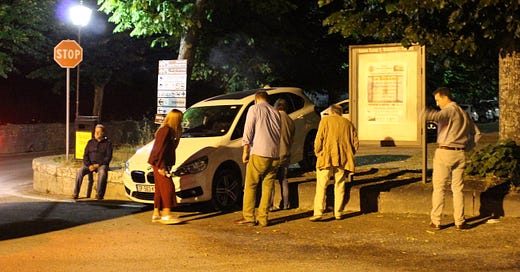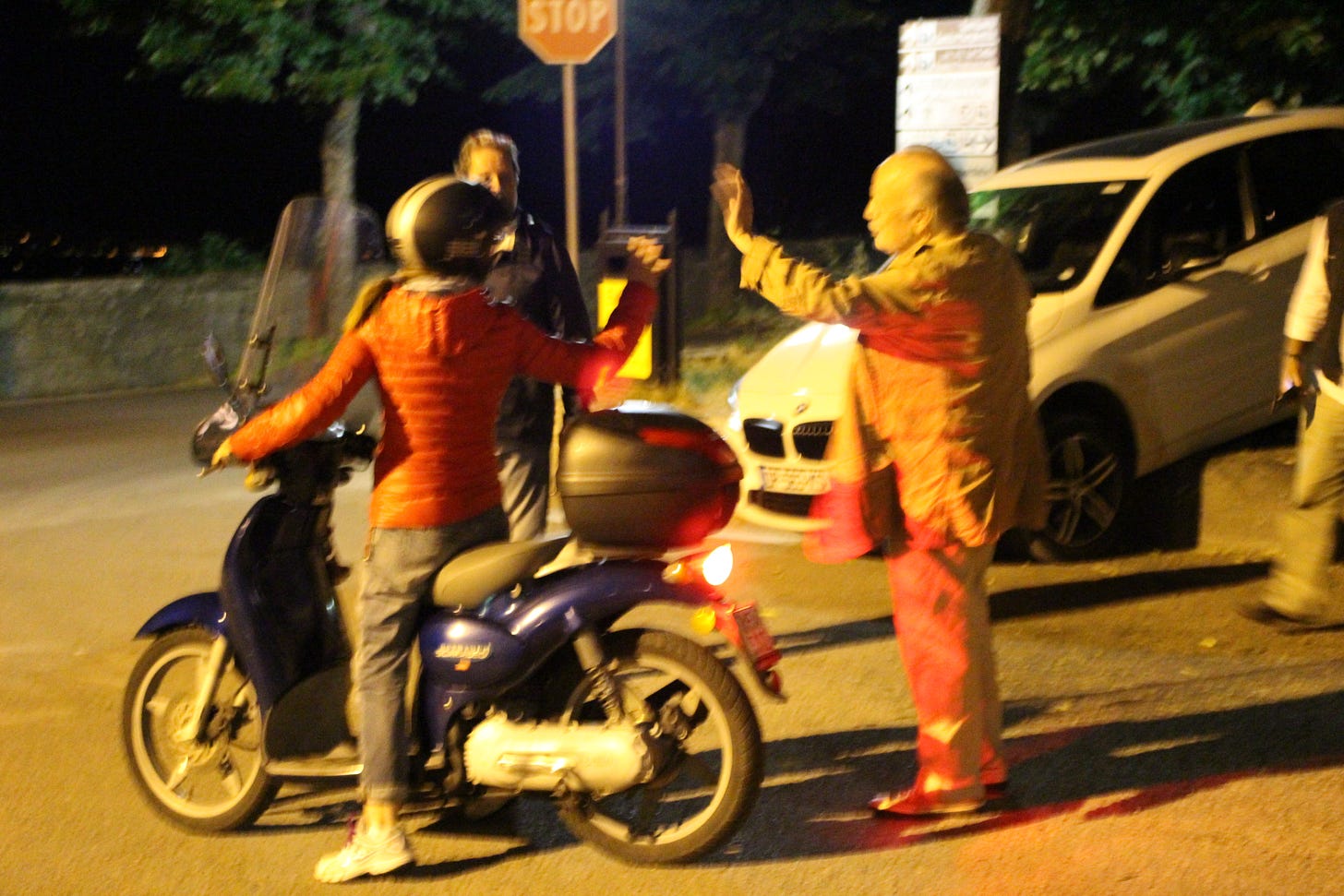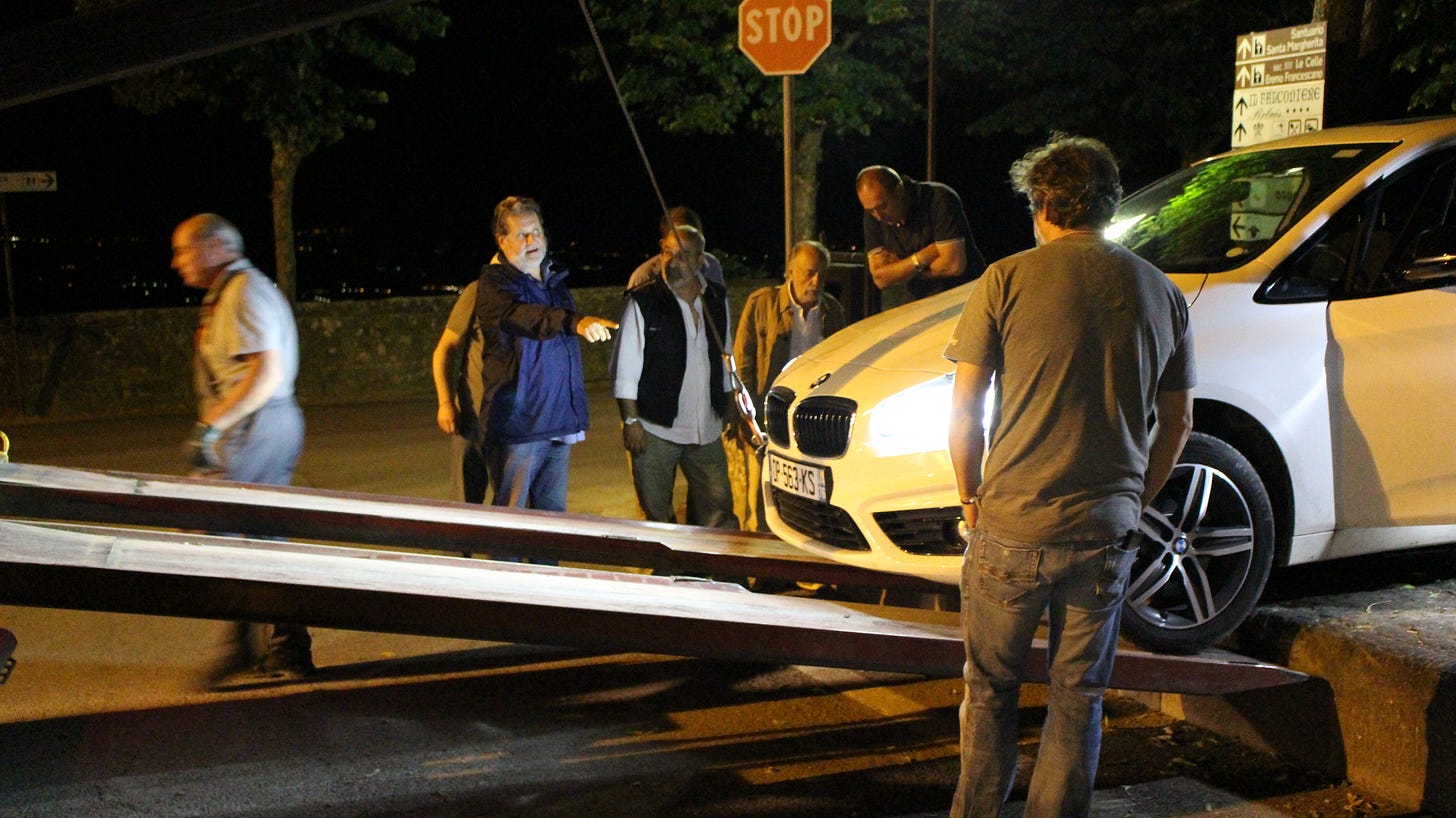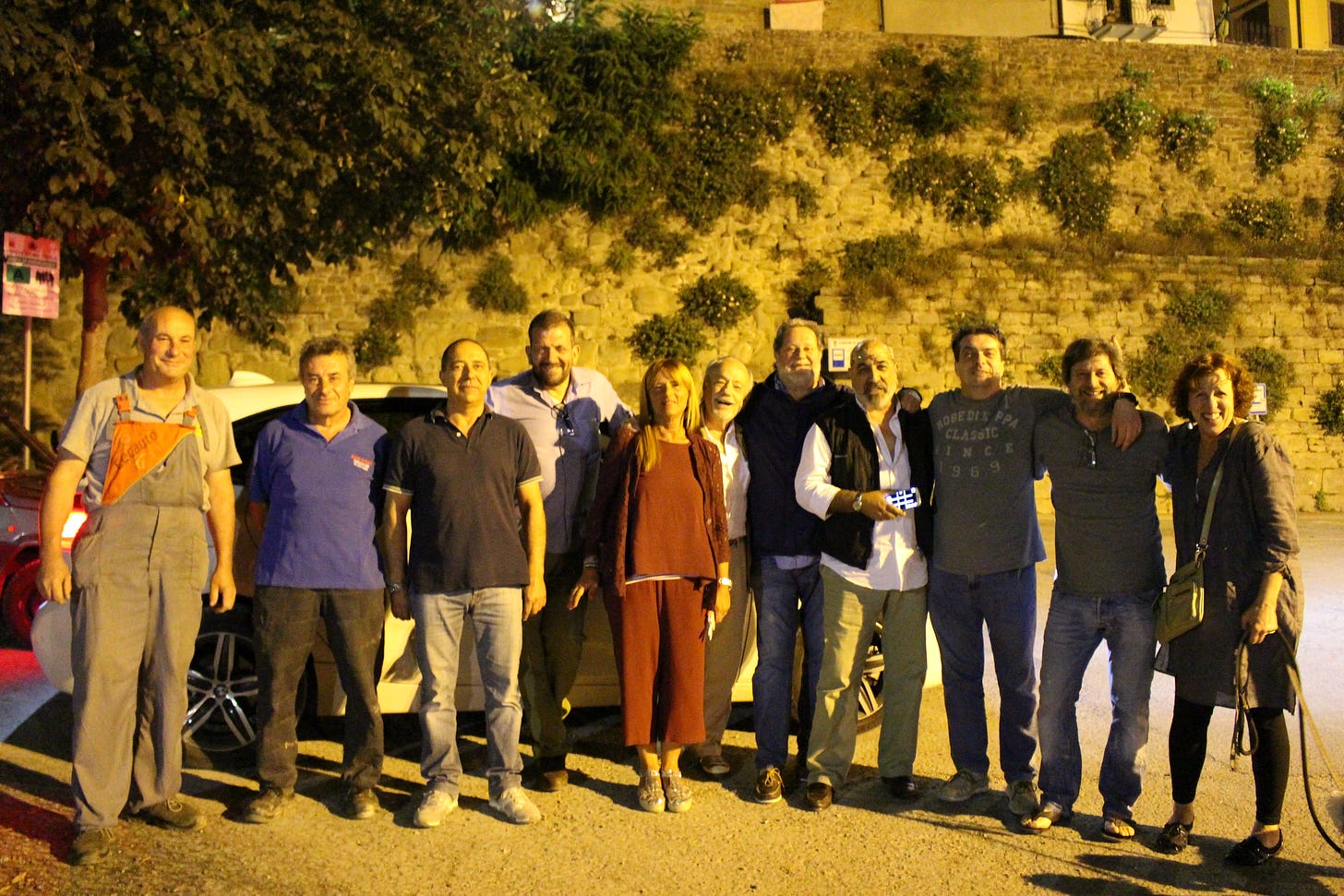Warning: The following may (probably) contain typos.
Wanna learn how to turn “yawn” moments into jaw-dropping, dinner-party-dominating stories? The kind people remember. Quote. Share. Maybe even steal. Then do not skim this article. Read it to the end. But first—a word from our completely biased, utterly brilliant sponsor: me.
If you’re reading this and not subscribed, let me tell you why you’ll live to regret it. Thought I’d take a Mafia-oso approach!
Here’s why you need to hit that button (and yes, I’ll keep it semi-brief). You’ll get the behind-the-scenes playbook on how great stories really work. You’ll get sharp recs on what to read and watch—and the inside scoop on why it all hits hard. I’ll take you into the guts of storytelling and MORE (see full list below)
More than that—you’ll reclaim your creative voice and start shaping your life like it’s the story you were meant to star in.
I’ve spent four decades in the storytelling trenches—Hollywood, Europe, classrooms, chaos—and I didn’t just survive. I came back with treasure. Now I’m handing it to you. At $75 for a year, you can’t afford not to subscribe!
Subscribe. Read. Reinvent. Let’s make some noise.
SWAG for Subscribers:
This isn’t a newsletter reviewing or critiquing the latest Netflix show. Instead, we’ll take a deep dive into a single story - film, TV, fiction, memoir, or even a piece of music and look under the hood: How it’s structured, and why it works (or doesn’t). Stripping it down to its bare essentials will give you a greater understanding of how to craft your own ideas.
🎤 3 Live Sessions a Year
Stuck? Blocked? Spinning out in doubt? Bring your questions, your struggles, and your half-baked ideas. No gatekeeping. No ego. Just real talk and real tools to get you moving again.
✍️ Hollywood Writers Room (Weekly!)
One-hour creative play. Exercises to stretch your boundaries and build confidence. Cameras optional. Pajamas encouraged.
✍️ 3 Naked Pages. Share the pages you hate or make you cringey even thinking about the
🎤 Sadie Jones Live. Award-winning novelist and screenwriter will share her approach to writing and adapting her work – and answers your questions.
💬 Bonnie’s Babes Private Chatroom
It started with storytelling. But it became a sisterhood. “Bonnie’s Babes” are wildly talented women who Zoomed in as strangers and Zoomed out as lifelong friends. They support one another whether it’s showing up for another’s opening, meeting up for a drink or shoulder to cry on.
🎬 Pitch Perfect. You may write the next Tale of Two Cities, but if you can’t pitch it, you won’t sell it. I went from (literally) putting a producer asleep to selling ideas on the spot. Learn how to bring a story to life verbally. We’ll cover how to craft a killer verbal pitch, plus a pitch deck that wow managers, agents, and buyers.
AND…if you still can’t get enough of me…check out a recent podcast
In summer, my mind turns to disaster. That's because summer is the time of year when my husband and I travel abroad. We consider ourselves well-traveled. Nonetheless, every excursion brings an unexpected twist, throwing our plans and mental health into a tailspin. It's inevitable. The further from home, the greater distance you put between you and your comfort zone, the more likely something goes awry. (Side note: When I hosted my one day workshop in London, I used a different disaster as a jumping off point. My life, and no doubt yours, is filled with them).
When you've returned from holiday, nobody wants to hear about your ten-course dinner in a 17th-century chateau in the foothills of the Alps. They'd rather hear how the locally sourced wine gave you hives, and you broke into a pharmacy to get calamine lotion (or the French equivalent).
Once upon a time, an unexpected disaster triggered a meltdown. Now I contextualize the nightmare and appreciate its long-term benefits, reminding myself when and if I get home, the present misery will morph into storytelling gold in the weeks, months, and years.
One of our cardinal rules of flying is no checked bags. We had no choice given the length of time we'd be gone, plus the dogs and an occasional guest. We needed a full-size car with lots of trunk space. When we got to Paris Orly, the only car large enough to fit us and our crap was a BMW SUV. For the cost of the insurance, we could've purchased a Prius in the States. We declined the insurance, deciding instead to rely on the insurance provided by the credit card we used for the rental. The extra insurance wasn't necessary. We were experienced, European drivers. The last words the French rental agent said, in the only fluent English he spoke, "If anything happens, you must purchase the car."
Two weeks later, Jim, Jess Mollo, our friend/guest and my former USC screenwriting student, and I strolled the empty streets of Cortona, Italy, under a starry sky, following a heavenly meal. The first time I saw Cortona was a year or so after "Under the Tuscan Sun." We entered the city gates, teeming with tourists, turned around, and left. A decade later, the crowds had moved on. We marveled how walking through the town and down the hill to our car parked outside the walled gates; we never saw a living soul.
Our car was parked outside the walled gate in a makeshift parking lot constructed from dirt and ancient stones. It was jam packed when we arrived. Now, ours was the only car. Jim got behind the wheel, Jess slid into the back with our two dogs, and I got in the passenger seat. A minute later, we're perched at a 30-degree angle, wedged into the stone steps. What Jim thought was an exit turned out to be ledge.
It was after midnight on a Monday in the countryside of Italy. We had cell phones, but who would we call? Panic bells went off in my head. The voice of the rental car guy, issuing his warning, echoed in my head. I guess we now owned a BMW SUV. But first, it would need to be repaired. There had to be extensive damage. Next, we’d have to figure out how to pay for it. Once it was up and running, what the hell were we going do with a car in Italy when we lived in California?
Then something unexpected happened. Had it happened in a movie, you'd groan because it defied credulity; a half dozen men and a woman suddenly appeared. Materialized out of thin air. I have no idea where they came from. They just appeared. No one spoke a word of English, and we, obviously, spoke no Italian (unless you count Prosecco as Italian). They immediately mobilized into action. Talking excitedly to each other, all at once, crawling under and around the car, huddling, and deciding the best course of action. They would try to lift the car: six men and a 6000-pound vehicle. Fortunately, the one woman in the group squashed that idea.
Undeterred, they whipped out their cell phones and began dialing numbers. Who the hell were they calling in the middle of the night in Cortona? AAA?!! More friends to help lift the SUV?
I watched from a distance, not wanting my anxiety and negativity to taint these lovely but deluded Italians.
During all this, we'd become a roadside attraction. From out of nowhere, people began appearing in cars, motorcycles, foot. It morphed into a Fellini film. Jim and Jess are having the time of their lives, taking pictures, and exchanging emails. Everyone was having a fantastic time while I desperately struggled not to have a meltdown.
Then an actual miracle. A tow truck appeared—a tow truck at 1 AM in Cortona. Assuming you could get a tow truck at 1:00 AM in Los Angeles, you'd be thrilled if it arrived within two hours. Cheers rang out. The men consulted with the tow truck driver.
Once it was clear the car could be lifted off the stone, the question remained what kind of shape would it be in? The car not the stone. The stone had survived centuries. Automative technology didn’t have as great a track record.
Twenty minutes later, the car was sitting on the road. Not only was it okay to drive, there wasn't so much a scratch on it!
Several men lifted the huge stone and put it back into place, good as new. Or good as ancient new.
More celebrations and an exchange of emails. The tow truck driver pictured on the far left, convinced the incident happened because Jim was drunk. He wanted to drive us home to make sure we made it safely. We convinced him Jim wasn’t drunk, just a fish-out-of-water American.
When it comes to telling our own stories, we discount them. It's hard to see something that's happened to us as material. We think of ourselves and our experiences as commonplace. When we're personally involved in an event, it's impossible to separate ourselves from it. But if we do, we can mine gold.
A facile imagination can take the seemingly most mundane event and make it unforgettable.
Let's use the story you just read as an example. You have the fact; now, let's reimagine it.
As it happens, my story is funny on its own. But what if it wasn't? Would it have made it any less compelling? That depends on what I want to do with it.
What is the story? And do we build on the facts? Where do we start?
There is no right or wrong place to start. That's the good and bad news of writing. THERE ARE NO DEFINITIVE ANSWERS.
Writing isn't math. There’s isn’t a right or wrong answer. The “answer” is what works for your story? That makes it more of a question than an answer! Are you trying to move the reader to tears of joy or despair? Do you want us to feel like we're a participant in the story or an outsider looking in?
Let's take the story I just relayed about our experience in Cortona. I want to rewrite it. I’d begin asking obvious questions. Where did the car break down? Was it on your street corner? Was it on a deserted highway at 3:00 AM? Or a country road where you'd never been and don't speak the language? It isn't a trick question. The answer: whatever resonates with you. If the car breaks down on a desert road, it sets up one kind of expectation. If it happens on a busy freeway, it will likely prompt a different reaction.
When you know what, specifically, you're trying to communicate, it helps you focus and craft your story. The "takeaway" (that Hollywood term I keep referring to) from my story is there's no such thing as a language barrier. It's not about how I phrase the takeaway. Hopefully, the audience will figure it out. But the person who needs to understand the intention is the writer.
I could take the same story and turn it into a dark thriller. We're stuck on the same ancient stone, but nobody comes to help. One person stays with the car, and the other two set off to find help. A motorcycle appears. The driver can take one, not two. One having one, alone, in the dead of night. It starts to pour rain, they’re disoriented. Finally a car…but we know what she doesn’t, there’s a manhunt underway for a car like this. You see my point. And I put zero time and effort into that story! I just wrote down the first thing that popped into my head.
Stories are about making choices. It's creatively and emotionally liberating when we stop framing or judging those creative choices as right or wrong. They can't be either because you're making it up. Our job as writers is to serve the story. Writers are eternally seeking the correct answer. Once we embrace the idea there isn't one, we untether ourselves from fear and soar.








